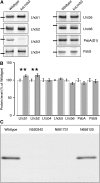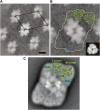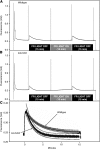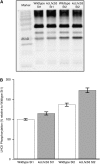The photosystem II light-harvesting protein Lhcb3 affects the macrostructure of photosystem II and the rate of state transitions in Arabidopsis
- PMID: 19880802
- PMCID: PMC2782274
- DOI: 10.1105/tpc.108.064006
The photosystem II light-harvesting protein Lhcb3 affects the macrostructure of photosystem II and the rate of state transitions in Arabidopsis
Abstract
The main trimeric light-harvesting complex of higher plants (LHCII) consists of three different Lhcb proteins (Lhcb1-3). We show that Arabidopsis thaliana T-DNA knockout plants lacking Lhcb3 (koLhcb3) compensate for the lack of Lhcb3 by producing increased amounts of Lhcb1 and Lhcb2. As in wild-type plants, LHCII-photosystem II (PSII) supercomplexes were present in Lhcb3 knockout plants (koLhcb3), and preservation of the LHCII trimers (M trimers) indicates that the Lhcb3 in M trimers has been replaced by Lhcb1 and/or Lhcb2. However, the rotational position of the M LHCII trimer was altered, suggesting that the Lhcb3 subunit affects the macrostructural arrangement of the LHCII antenna. The absence of Lhcb3 did not result in any significant alteration in PSII efficiency or qE type of nonphotochemical quenching, but the rate of transition from State 1 to State 2 was increased in koLhcb3, although the final extent of state transition was unchanged. The level of phosphorylation of LHCII was increased in the koLhcb3 plants compared with wild-type plants in both State 1 and State 2. The relative increase in phosphorylation upon transition from State 1 to State 2 was also significantly higher in koLhcb3. It is suggested that the main function of Lhcb3 is to modulate the rate of state transitions.
Figures






Similar articles
-
The light-harvesting chlorophyll a/b binding proteins Lhcb1 and Lhcb2 play complementary roles during state transitions in Arabidopsis.Plant Cell. 2014 Sep;26(9):3646-60. doi: 10.1105/tpc.114.127373. Epub 2014 Sep 5. Plant Cell. 2014. PMID: 25194026 Free PMC article.
-
Analysis of state 1-state 2 transitions by genome editing and complementation reveals a quenching component independent from the formation of PSI-LHCI-LHCII supercomplex in Arabidopsis thaliana.Biol Direct. 2023 Aug 23;18(1):49. doi: 10.1186/s13062-023-00406-5. Biol Direct. 2023. PMID: 37612770 Free PMC article.
-
Phosphorylation of the Light-Harvesting Complex II Isoform Lhcb2 Is Central to State Transitions.Plant Physiol. 2015 Dec;169(4):2874-83. doi: 10.1104/pp.15.01498. Epub 2015 Oct 5. Plant Physiol. 2015. PMID: 26438789 Free PMC article.
-
Excitation energy transfer and charge separation are affected in Arabidopsis thaliana mutants lacking light-harvesting chlorophyll a/b binding protein Lhcb3.J Photochem Photobiol B. 2015 Dec;153:423-8. doi: 10.1016/j.jphotobiol.2015.11.002. Epub 2015 Nov 9. J Photochem Photobiol B. 2015. PMID: 26562806
-
Functions and Evolution of Lhcb Isoforms Composing LHCII, the Major Light Harvesting Complex of Photosystem II of Green Eukaryotic Organisms.Curr Protein Pept Sci. 2018;19(7):699-713. doi: 10.2174/1389203719666180222101534. Curr Protein Pept Sci. 2018. PMID: 29473498 Review.
Cited by
-
Arabidopsis plants grown in the field and climate chambers significantly differ in leaf morphology and photosystem components.BMC Plant Biol. 2012 Jan 11;12:6. doi: 10.1186/1471-2229-12-6. BMC Plant Biol. 2012. PMID: 22236032 Free PMC article.
-
Thylakoid membrane reorganizations revealed by small-angle neutron scattering of Monstera deliciosa leaves associated with non-photochemical quenching.Open Biol. 2020 Sep;10(9):200144. doi: 10.1098/rsob.200144. Epub 2020 Sep 16. Open Biol. 2020. PMID: 32931722 Free PMC article.
-
Downregulation of Light-Harvesting Complex II Induces ROS-Mediated Defense Against Turnip Mosaic Virus Infection in Nicotiana benthamiana.Front Microbiol. 2021 Jul 5;12:690988. doi: 10.3389/fmicb.2021.690988. eCollection 2021. Front Microbiol. 2021. PMID: 34290685 Free PMC article.
-
Phos-tag-based approach to study protein phosphorylation in the thylakoid membrane.Photosynth Res. 2021 Jan;147(1):107-124. doi: 10.1007/s11120-020-00803-1. Epub 2020 Dec 2. Photosynth Res. 2021. PMID: 33269435 Free PMC article.
-
Editorial.Photosynthetica. 2023 Dec 19;61(4):398-404. doi: 10.32615/ps.2023.044. eCollection 2023. Photosynthetica. 2023. PMID: 39649483 Free PMC article. No abstract available.
References
-
- Ahn, T.K., Avenson, T.J., Ballottari, M., Cheng, Y.-C., Niyogi, K.K., Bassi, R., and Fleming, G.R. (2008). Architecture of a charge-transfer state regulating light harvesting in a plant antenna protein. Science 320 794–797. - PubMed
-
- Allen, J.F. (2003). State transitions - A question of balance. Science 299 1530–1532. - PubMed
-
- Allen, J.F. (2005). Photosynthesis: The processing of redox signals in chloroplasts. Curr. Biol. 15 929–932. - PubMed
-
- Allen, J.F., and Forsberg, J. (2001). Molecular recognition in thylakoid structure and function. Trends Plant Sci. 6 317–326. - PubMed
Publication types
MeSH terms
Substances
Associated data
Grants and funding
LinkOut - more resources
Full Text Sources
Other Literature Sources
Molecular Biology Databases
Research Materials

